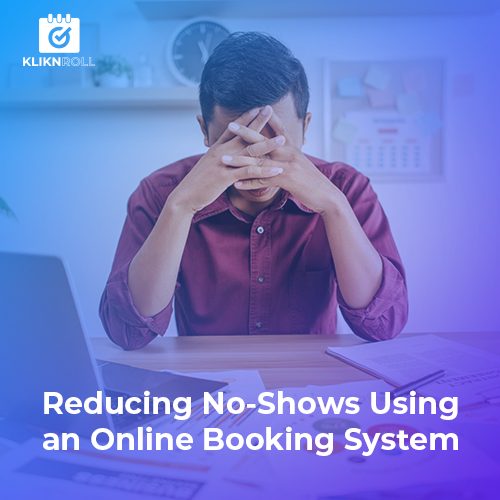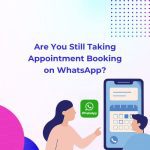Table of Contents
What is a No-Show?
A no-show occurs when a scheduled appointment isn’t honored by the client or customer without prior notification or cancellation.
When we take a closer look, it’s clear that the reasons people miss appointments are complex. Often, it’s because they don’t see the value in the appointment, or maybe they’re facing logistical hurdles, or life just gets in the way.
Take, for example, someone who misses an appointment because their day is packed and the meeting’s importance wasn’t made clear.
Or maybe how tough it can be to find the place or how off-putting long waits are.
Things like last-minute emergencies or having to juggle too many things at once, also play a part in why people don’t show up, even when they fully intend to.
By understanding the many reasons behind missed appointments and taking steps to deal with them, businesses can reduce the hassle, make customers happier, and, in the end, run a smoother operation.
How to Reduce No-Show Appointments
Understand Why People Don’t Show Up
Before we get into the other tips, the first thing to figure out is exactly why people in your particular industry don’t show up. In the healthcare industry, like clinics and dental offices, the fear factor can often deter people from showing up.
On the other hand, in industries like restaurants or spas, the reasons for no-shows can be harder to quantify, ranging from a last-minute change of mind to price sensitivity.
The first thing you can do to find out is to send out surveys as to why they didn’t make their appointments.
In our experience, most of them won’t answer but the ones who do might genuinely have a reason to do so – which you can then improve upon.
Maybe it was too difficult to change the appointment? Or maybe the wait time is too long, based on their previous experience.
Data and feedback are always the most important things when solving an operational problem.
Provide a Good Customer Booking Experience
A good booking experience is important if your ultimate goal is to reduce no-shows. Think about it, that’s the first point of contact between them and your company.
A great way to improve the experience is through a well-designed online booking system. Well-designed in this context refers to both being visually appealing, alongside a good user experience.
Many companies overlook this, but it’s a great way to build customer loyalty through brand impressions and brand rituals. Loyal customers will be a lot less likely to not show up for an appointment!
If you’re interested in a robust online booking system that has all the capabilities that you could ever want, check out Click2Book, our premier online booking system!
Prompt Automated Reminders on All Relevant Channels
Automated reminders are a given and should be included in any reservation process. We’d recommend going with reminders 24, 6, and 1 hour in advance for the best results.
However, according to data from our own clients, we’ve found no-shows are reduced significantly if reminders are sent on more than one channel.
Email is the default, but of course, sometimes people might miss emails as on average, people receive around 120 emails a day. Not to mention, there is a small chance that your email might end up in spam.
To mitigate this issue, here are the platforms that we recommend sending automated reminders to:
- Emails
- Text/SMS
- Facebook Messenger (Through Chatbots)
- Instagram Chat (Through Chatbots)
Please note that you should pick one, whether it be Facebook Messenger or Instagram Chat, whichever is more convenient for your audience. You don’t want to come off as overly intrusive.
The key here is to send a gentle reminder (that must be worded properly).
Make It Easy for Customers to Change Appointment Timeslots
Another important thing that you should do is to make it easy for your customer to change their appointment timeslots or edit any requests. This is where the booking platform that you choose will come into play.
Unfortunately, not many platforms allow for easy edits. However, using a platform like Click2Book, your customers can easily log in and edit any changes.
You’ll be updated in real-time through notifications and it can also be recorded in your CRM system.
Not to mention, it’ll show up on your customer’s profile history, so you’ll be able to keep tabs on how frequently they change their appointments or cancel, etc.
Build Loyalty to Mitigate No-Shows
As we’ve mentioned earlier in the article, loyal customers are a lot less likely to bail on appointments. So to reduce the overall no-show rate, you should aim to build loyalty as a whole.
One way to improve customer loyalty is to ensure every aspect of the customer journey goes well. This means everything from the initial booking, the average wait time, the quality of the service, etc.
Having a great value proposition is also incredibly important, meaning the quality of service per dollar paid. Customers tend to come back more often if this criteria is fulfilled, among the things that we mentioned.
Loyalty is a whole other ballgame that needs multiple articles to explain in detail. However, for now, take a look at the next tip on what we think is the single best way to incentivize customer loyalty and decrease no-show rates!
Practice Giving Incentives to Loyal Customers
Customers love incentives, and it’s a great way to build loyalty at scale, for almost any business. Of course, it also helps reduce no-shows too. While discounts are common, there are more effective options.
Vouchers, for instance, encourage repeat visits, creating a sort of brand ritual. Additionally, using customer data to offer personalized incentives can further strengthen the relationship.
The goal is to create a mutually beneficial dynamic that keeps customers coming back and reduces the likelihood of missed appointments, ultimately reducing costs and encouraging business growth.
Use Data to Understand & See What Can Be Improved
Using data effectively can make a big difference in tackling no-show appointments.
You can start by looking at past appointment records to spot trends like specific days or times when no-shows are more common, or if certain services or staff members are involved.
Keeping track and really understanding these trends can help you tailor your approach, whether it’s adjusting schedules, sending targeted reminders, or improving service.
Also, as we’ve mentioned, gathering feedback from customers to learn why they might be missing appointments is something that is incredibly important.
Try out surveys or follow-up messages that can give you information about what needs fixing, so you can improve and enhance the overall experience.
For instance, if you find out that a lot of no-shows happen during busy hours, you might try offering incentives for booking at quieter times.
Continuously monitoring and analyzing your data lets you fine-tune your strategies over time, making sure that you’re always on top of things and delivering the best service possible!
Manage Your Online Reputation & Reviews
Your online reputation plays a big role in whether customers show up for appointments. Imagine this: someone sees your ad on social media and decides to book, but then they Google your brand and find lots of 1-star reviews.
They’re probably less likely to actually come in. That’s why it’s so important to stay on top of your online reputation and reviews.
Aim for ratings between 4.2 to 4.5 stars because those are the ones that build the most trust.
Good reviews not only build trust but also lead to more bookings. It doesn’t do much good to be number one on Google Maps if customers are choosing competitors with better reviews in the second or third spots.
Have Enough Relevant Information on Your Website or Google Business Profile
Making sure your website or Google Business profile includes the right info is one of the biggest ways to cut down for cutting down on no-shows.
The basics are of course things like contact info and hours. However, we would recommend including things like information regarding the services that you provide.
Offering online booking right from your site or Google profile is something you should look into.
You can also utilize the updates feature on your Google Business Profile to let your customers know if anything has changed.
You might not see an immediate effect on your overall no-show rate, but it will improve over the long run.
Make Sure You’re Reachable for Any Questions
Ensuring that your Google profile is up-to-date with information is crucial. However, it’s equally important to be consistently accessible to your customers.
A primary reason customers fail to keep their appointments is due to the lack of necessary information or difficulty in contacting businesses.
Your business must be readily contactable to encourage customers to honor their appointments.
The following platforms are recommended for maintaining open lines of communication:
- Texts
- Call
- Social Media
Aside from being reachable, you should be able to answer and satisfy your customer’s questions.
Charge a Deposit if Necessary
If all else fails, you could also charge a deposit for reducing no-show appointments. However, we’d only recommend this as a last resort.
This is because implementing a required deposit will no doubt decrease your overall conversion rate, which is not what you want.
Depending on the industry, the general rule of thumb that we recommend would be 10 to 30% of the estimated value of your service.
Specifically, for sectors such as restaurants and catering services, a scalable deposit model is what we’d recommend.
This model would entail a deposit that scales in proportion to the party size, which is fair to the business.
Our reservation platform has a seamless payment feature, if you need it.
You have the flexibility to define the criteria for activating the deposit feature.
For example, the system can be configured to automatically trigger a deposit requirement once the number of guests for a restaurant booking surpasses six.
How to Address Customers That Consistently No-Show?
When dealing with customers who consistently no-shows, it’s important to take a proactive and personalized approach.
Rather than resorting to punitive measures like a ban immediately, try reaching out to understand why they did not show up.
It could be anything from forgetfulness to dissatisfaction with the service. Talk to them to express concern and offer support, if it’s good practice in your industry.
For instance, you might offer to reschedule appointments at more convenient times or provide additional reminders tailored to their preferences.
If you address their specific needs and concerns, you can show your commitment to their satisfaction and potentially turn them into loyal customers.
However, if despite your efforts, they continue to no-show, it may be time to implement a policy that protects your business interests while still maintaining professionalism and empathy.
Only then, you can introduce things like deposits for future appointments or setting up a limited number of no-show allowances before additional consequences are enforced.

Hey there! I’m Jeffrey Hau, and my journey in the digital world started after I wrapped up my psychology degree at UCLA. Imagine coming back to the bustling streets of Hong Kong from the tech haven of Silicon Valley – it was a whirlwind of inspiration! Seeing how social media platforms were evolving at breakneck speed and realizing the limitations of traditional advertising in this digital age, I decided to dive in.
In 2012, I laid the foundation of Prizm Group. From our humble beginnings, we’ve now blossomed into a global powerhouse with a team of over 200 passionate professionals. Our HQ is right here in Hong Kong, and we’ve spread our wings to SG, AU, NZ, JP, and China.
As a digital problem solver, our team found that several industries are in need of reservation systems, especially for F&B, Hotels, Beauty, and Medical sectors. Our digital magicians started crafting reservation systems tailored to cater to these specific needs. We extended our expertise to e-commerce, voucher management systems, and campaign management systems, combining them into KlikNRoll – an all-in-one solution. We deep dive into various industries, understanding their unique challenges and developing innovative solutions.
We’re not just a company; we’re your dedicated partners in transforming how you navigate the digital landscape. Our passion lies in providing businesses with intuitive and tailored solutions using KlikNRoll’s powerful capabilities.
Ready to embark on this exciting digital adventure with us? Let’s make your brand stand out in the digital jungle!






